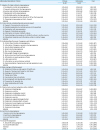1. Korea Immigration Service. Statistical yearbook of immigration and foreign policy in 2016. Gwacheon: Ministry of Justice;2017. p. 1–2.
2. Chung HS, Kim YS, Yi TM, Ma KH, Choi YJ, Park GP, et al. Report No. 2016-03. An analysis on the national survey of multicultural families 2015. Sejong: Ministry of Gender Equality and Family;2016. p. 49–52. p. 218–220. p. 223–224.
4. Kim HR, Yeo JY, Jung JJ, Bak SH. Health status of marriage immigrant women and children from multicultural families and health policy recommendations. Sejong: Korea Institute for Health and Social Affairs;2012. p. 131–137.
6. Park H, Park M, Chun Y. A study on education needs related to prenatal care programs in married immigrant women. Journal of the Korea Academia-Industrial Cooperation Society. 2015; 16(7):4632–4640.

7. Kim EH, Lee E, Kim MJ, Park DY, Lee SH. Effects of an educational program of pregnancy and delivery on pregnancy related knowledge, newborn care knowledge, and postpartum care self-efficacy of marriage immigrant women. Korean Society of Nursing Science. 2010; 40(1):78–87.

8. Jeon MS, Kang KJ, Park SH. A study on pregnancy, delivery, and infant rearing knowledge and educational need of marriage immigrant women. Journal of Agricultural Medicine and Community Health. 2011; 36(3):179–190.

9. Kim SH. Pregnancy and childbirth experiences of Chinese marriage immigrant women. Journal of the Korean Society of Maternal and Child Health. 2012; 16(2):170–185.
10. Kim KW, Jeong GH. Development of a scale to assess immigrant women's needs for pregnancy and postpartum adaptation. Korean Journal of Women Health Nursing. 2013; 19(4):242–253.

11. Roy SC, Andrews HA. The Roy adaptation model. 2nd ed. Stanford: Appleton & Lange;1999.
12. Kim Y, Kim Y. A need analysis of parental education for female marriage immigrants. Journal of Korean Education. 2011; 38(1):55–81.
13. Choi DH. A Study on the meaning of “becoming a mother” of Vietnamese migrant women. Journal of Diaspora Studies. 2015; 9(2):233–256.
14. Giger JN. Transcultural nursing assessment and intervention. 7th ed. St Louis: Elsevier;2017. p. 394p. 437–438. .
15. Kim HR, Bak SH, Jung HW, Lee YR, Kim AJ. Survey on dietary behaviors and needs for nutrition service, and developing contents of nutrition education for female immigrants in multi-cultural families in Korea. Sejong: Korea Institute for Health and Social Affairs;2011. p. 70–86.
16. So JS, Han SN. Diet-related behaviors, perception and food preferences of multicultural families with Vietnamese wives. Korean Journal of Community Nutrition. 2012; 17(5):589–602.

17. Oh EJ, Park JS, Kim YK, Lee HS. The meaning of pregnancy and childbirth experience of women in multi-cultural family. Journal of the Korean Society of Maternal and Child Health. 2013; 17(2):256–269.

18. Kim HR. Health problems of multi-cultural families and policy task. Health and Welfare Issue & Focus. 2013; (185):1–8.
19. Lim HS. The experience of health care in pregnancy and childbirth among married immigrant women in Korea. Journal of Qualitative Research. 2014; 15(2):117–129.
20. Joo YJ. Research on the delivery of the marriage migrant women from Vietnam [master's thesis]. Seoul: Chung-Ang University;2014. 87.
21. Lee EJ, Jun MK. A study of Vietnamese immigrant women's ‘adaptation experiences’, within the socio-cultural context of their home country. Journal of Korean Home Management Association. 2014; 32(5):63–86.
22. Du W, Cho J. A life history research on acculturation of Chinese marriage immigrant women in Korea. Journal of Women's Studies. 2017; 27(1):109–141.
23. Chong SW, Huang HY. A case study on the gender equality experience of Chinese married immigrant women in Korea. Asia-Pacific Journal of Multimedia Services Convergent with Art, Humanities, and Sociology. 2018; 8(2):657–666.








 PDF
PDF ePub
ePub Citation
Citation Print
Print



 XML Download
XML Download